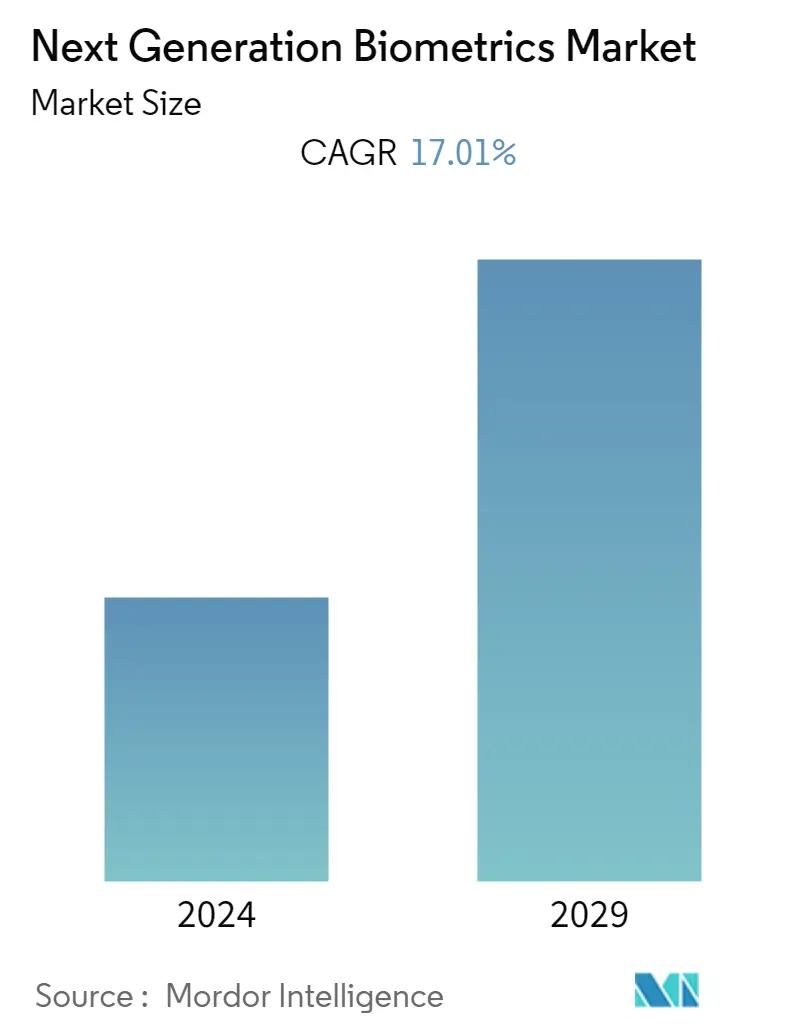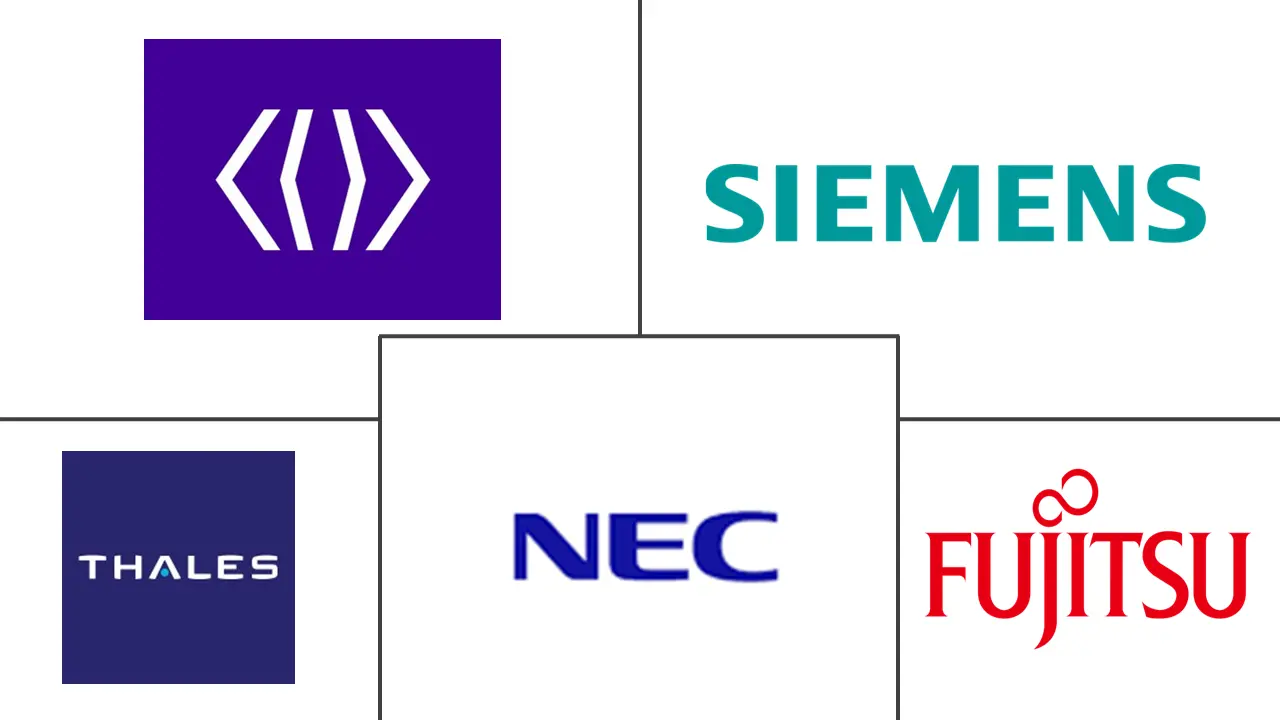Market Size of Next Generation Biometrics Industry

| Study Period | 2019 - 2029 |
| Base Year For Estimation | 2023 |
| CAGR | 17.01 % |
| Fastest Growing Market | Asia Pacific |
| Largest Market | North America |
| Market Concentration | High |
Major Players
*Disclaimer: Major Players sorted in no particular order |
Next Generation Biometric Market Analysis
The Next Generation Biometrics Market size is expected to grow from USD 42.96 billion in 2023 to USD 94.23 billion by 2028, at a CAGR of 17.01% during the forecast period (2023-2028).
One of the key trends witnessed in the next-generation biometrics market is a paradigm shift in business discourse toward more privacy and fewer security threats. The end-users are increasingly looking for integrated solutions rather than depending on conventional methods.
- The next-generation biometric market is anticipated to grow at a significant growth rate due to the rising number of terrorist activities, coupled with the increasing theft activities on the part of crucial data and information that have raised concerns regarding national security. For instance, in August 2022, Chile is implementing an automatic biometric identification system (ABIS) to combat organized crime. By comparing the biometric records of the civil police (PDI), the civil registry, and Interpol, the system would instantaneously identify recognized criminals, illegal migrants, and the deceased who lack any identity.
- The rising identity fraud across the globe is restricting market growth globally. According to Onfido, Identity fraud rose 43% YoY, with sophisticated fraud increasing 57% as criminals employed smarter tactics, utilizing realistic 2D/3D masks and deploying display attacks (for instance, showing a picture of a person on a screen) to try to spoof verification systems. And with 9 out of 10 consumers comfortable accessing digital services, the opportunities for fraudsters are further increasing.
- The next-generation biometric industry benefits from the increase in electronic cards and biometric passports. Costa Rica, for example, in September 2021, is slated to launch its biometric passport in 2022. The new passport was created using the most advanced security technology to reject fraudulent attempts. It also complies with the demands the International Civil Aviation Organization sets forth. Throughout the projected term, these advances may generate growth opportunities for market development.
- The COVID-19 outbreak significantly increased demand for touchless biometrics solutions, particularly in the healthcare sector, and created substantial disturbances and adjustments in various industries. Advanced multifactor and multimodal biometrics solutions are becoming increasingly important due to their accuracy and conformance with COVID-19's social separation norms.
- Companies must refrain from using fingerprint, palm print, and hand-key scanners to minimize physical touch and virus transmission. These actions are laying the groundwork for facial identification equipment and user-friendly iris scanning, which will be applied in several contexts. The outbreak brought about a trend toward contactless biometric technologies that assess face, gait, and speech recognition for accurate identification, which benefitted the market growth and is expected to grow over the forecast period.
Next Generation Biometric Industry Segmentation
Next-generation biometrics are the technologies used to authenticate the individuals' identity through biological characteristics, such as facial expression, voice, palm, fingerprints, signature, iris, vein, and DNA. The biometric techniques are easy to use, and the data obtained is in digital format, which is hard to forge, duplicate, and rebuild. Moreover, next-generation biometrics are available in various solutions that cater to many end-user verticals according to their needs.
The Next Generation Biometrics Market is segmented by type of solution (face recognition, fingerprint recognition, iris recognition, palm print recognition, signature recognition, and other types of solutions), end-user vertical (government, defense, travel and immigration, home security, banking and financial service, consumer electronics, healthcare, and other end-user verticals), and geography (North America, Europe, Asia-Pacific, Middle East and Africa, and Latin America). The market sizes and forecasts are provided in value (USD) for all the above segments.
| By Type of Solution | |
| Face Recognition | |
| Fingerprint Recognition | |
| Iris Recognition | |
| Palm Print Recognition | |
| Signature Recognition | |
| Other Types of Solutions |
| By End-user Vertical | |
| Government | |
| Defense | |
| Travel and Immigration | |
| Home Security | |
| Banking and Financial Service | |
| Healthcare | |
| Other End-user Verticals |
| Geography | |
| North America | |
| Europe | |
| Asia-Pacific | |
| Middle East & Africa | |
| Latin America |
Next Generation Biometrics Market Size Summary
The next-generation biometrics market is poised for substantial growth, driven by a shift towards integrated solutions that prioritize privacy and security. This market expansion is fueled by increasing concerns over national security due to rising terrorist activities and data theft. The adoption of advanced biometric systems, such as automatic biometric identification systems, is becoming more prevalent as countries seek to combat organized crime and enhance security measures. The demand for touchless biometric solutions has surged, particularly in the healthcare sector, as a response to the COVID-19 pandemic, which has accelerated the trend towards contactless technologies like facial and iris recognition. The banking and financial services sector is also witnessing a significant uptake of biometric authentication methods, such as fingerprint and voice recognition, to improve customer satisfaction and reduce fraud.
In the Asia-Pacific region, the next-generation biometrics market is experiencing rapid growth due to economic development, increased travel, and the proliferation of IoT devices. Governments and businesses are increasingly adopting biometric identification technologies across various sectors, including banking, healthcare, and retail, to enhance security and streamline operations. Notable developments, such as the implementation of facial recognition technology in traveler registration and biometric payment methods, are expected to further propel market growth. The market is highly competitive and fragmented, with key players like Idemia, Fujitsu Ltd., NEC Corporation, Thales Group, and Siemens AG investing in technological innovations to meet the rising demand. These advancements are anticipated to drive the market's expansion over the forecast period.
Next Generation Biometrics Market Size - Table of Contents
-
1. MARKET DYNAMICS
-
1.1 Market Overview
-
1.2 Market Drivers
-
1.2.1 Inclination of Growth toward E-Passport Program
-
1.2.2 Integration of Biometrics in Smartphones Driving Growth
-
-
1.3 Market Restraints
-
1.3.1 Fear of Privacy Invasion Challenging Growth
-
1.3.2 High Initial Cost of Systems Restricting Growth
-
-
1.4 Industry Attractiveness - Porter's Five Forces Analysis
-
1.4.1 Bargaining Power of Suppliers
-
1.4.2 Bargaining Power of Buyers
-
1.4.3 Threat of New Entrants
-
1.4.4 Threat of Substitute Products
-
1.4.5 Intensity of Competitive Rivalry
-
-
1.5 Technology Snapshot
-
-
2. MARKET SEGMENTATION
-
2.1 By Type of Solution
-
2.1.1 Face Recognition
-
2.1.2 Fingerprint Recognition
-
2.1.3 Iris Recognition
-
2.1.4 Palm Print Recognition
-
2.1.5 Signature Recognition
-
2.1.6 Other Types of Solutions
-
-
2.2 By End-user Vertical
-
2.2.1 Government
-
2.2.2 Defense
-
2.2.3 Travel and Immigration
-
2.2.4 Home Security
-
2.2.5 Banking and Financial Service
-
2.2.6 Healthcare
-
2.2.7 Other End-user Verticals
-
-
2.3 Geography
-
2.3.1 North America
-
2.3.2 Europe
-
2.3.3 Asia-Pacific
-
2.3.4 Middle East & Africa
-
2.3.5 Latin America
-
-
Next Generation Biometrics Market Size FAQs
What is the current Next Generation Biometrics Market size?
The Next Generation Biometrics Market is projected to register a CAGR of 17.01% during the forecast period (2024-2029)
Who are the key players in Next Generation Biometrics Market?
Thales Group, NEC Corporation, Fujitsu Ltd, Siemens AG and IDEMIA are the major companies operating in the Next Generation Biometrics Market.

